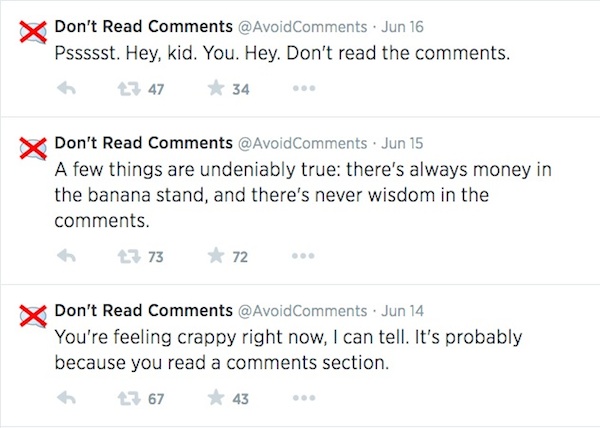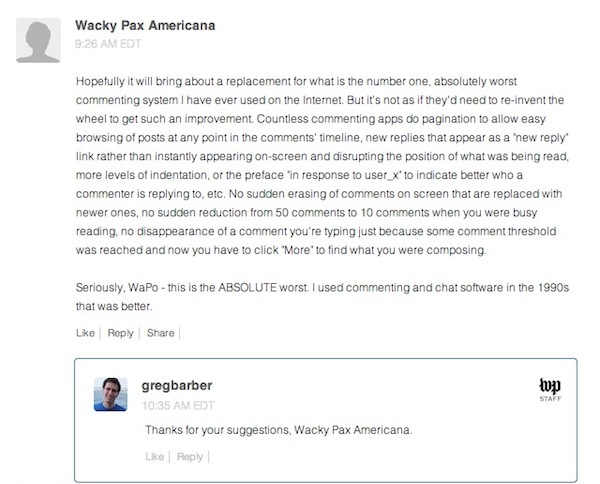
Both excitement and skepticism surrounded Thursday’s announcement that Knight has invested $3.89 million to help The New York Times, The Washington Post, and Mozilla collaborate on an open-source community engagement platform. Lots of people were simply confused — why does anyone need millions of dollars to build a commenting system?
NYT/WP teaming up is a good sign, but I’m not sure why they’d put resources into yet another commenting system. http://t.co/CZ94bV1ZCj
— Ricardo Bilton (@rbilton) June 19, 2014
Others pointed out that, while comments are a challenge, we have lots of other — better — platforms to talk to each other on.
I'm confused about this Mozilla/WaPo/NYT comments thing. Not sure what the hope is, besides providing an alternative to for-profit platforms
— Drake Martinet (@WithDrake) June 19, 2014
Others still rightly wondered whether new technology is really the answer to what seems to be a social-behavioral problem:
Tech as competitive advantage? nope. how you use it? yes! — Post, N.Y. Times, Mozilla team up for new comment system http://t.co/f24voeA7s6
— hassan hodges (@mapgoblin) June 19, 2014
All of these reactions are understandable. While collaboration on open source software for newsrooms — especially with two major news players involved — sounds like a good thing, lots of people feel like control over community engagement was ceded by news sites long ago.
Don't ever read the comments.
— Don't Read Comments (@AvoidComments) June 17, 2014
But in other corners of the Internet, some people were excited by the news of this major investment into community engagement, and ready for a change.

Greg Barber is the director of digital news projects at The Washington Post — he’ll be leading the paper’s team on this initiative. He says the idea for a Post–Times collaboration — which will be based in New York — came about through casual conversations between people in both newsrooms who worked on engagement platforms. “When it came down to it — no surprise, really — it seemed we had a lot of the same challenges and goals,” he says.
Staffers from both papers met, discussed the idea of a collaboration, and got approval from executives. Then they met with the Knight Foundation to discuss funding. “Anytime the New York Times and Washington Post raise their hands and say, We want to collaborate, and not only do we want to work together, but we want to make it open source, that’s going to get our attention,” says John Bracken, Knight’s director of journalism and media innovation. Knight agreed to fund a round of user research at a firm called Machine that helped them pinpoint the needs of both readers and publishers in the realm of community engagement.
Dan Sinker of Knight-Mozilla OpenNews was then brought on to help the two newsrooms facilitate their collaboration. Says Marc Lavallee, editor of interactive news at the Times, “I think a thing that’s really helpful about the Mozilla involvement — and Dan Sinker in particular — is that, if this was just two organizations who compete on pretty much everything trying to learn how to dance together, it would like an awkward freshman mixer.” In addition to monitoring the dance floor, Sinker’s team will be in charge of making sure the end product is something that can be used by all news organizations, not just those of Postian and Timesian scale.
Says Bracken, “This is partly a bet on Dan and his team. The OpenNews project has demonstrated an ability to really become a key part of this emerging community of digital news developers and designers.”
Sinker describes the project as a multi-faceted piece of newsroom infrastructure, a set of building blocks that will allow organizations to turn on or turn off various engagement features with relative ease. The software is not like Gawker’s Kinja, but it could be like Kinja; it’s not like Medium, but it could be like Medium; it’s not like Reddit, or The Huffington Post, or ProPublica, or Quartz, but it will draw from the lessons of all those organizations, and more.
“The main problem right now is either [newsrooms are] using out-of-the-box, proprietary systems that you can’t quite bend to the way you need them, or you’re building your own system, and building them very specific to the problem that you need to solve today,” Sinker says. The goal of the new system is to be flexible and customizable, but at a lower cost.
For example, your site could use an “identity login layer, coupled with a user-submission layer, coupled with an auto-moderation layer, and then you have a commenting system. Remove the auto-moderation layer, put in a part that’s about image processing or that accesses the Instagram API, throw in a backend that allows you to quickly approve or tag photos, and you have a photo submission system. That’s the idea. It should be a bunch of parts that you can assemble and reassemble.”
The team — which will consist of around a half dozen people from the Times, three or four from the Post, and a similar number from Mozilla — has two years to spend its grant (mostly on staffing, according to Sinker) and try to make their dream a reality.
That will mean similar, but slightly different, things for each paper. The Times has already built a number of innovative features around engagement — annotations, for example, and structured comments, in addition to traditional callouts for reactions and photographs. But while structured comments have been a popular initiative, they’re not easy to enable — a story that would benefit from them has to be tweaked and prepared by a developer. “They’re not exactly out-of-the-box,” says Sasha Koren, the Times’ deputy interactive news editor. The goal is to make it so that features like structured comments can be turned on or off by anyone. Says Lavallee, “The decision about what kind of commenting should be used on what kind of story should be able to be made by a community manager without having to tap on the shoulder of a developer.”There are also some new features that they would like to make available to the Times. “A page on The New York Times that shows you all your comments, who moderated them, and so on? That doesn’t exist. Being notified when someone else responds to a comment that was approved so you can go back with them and have a conversation on the site? That doesn’t exist. That’s the problem,” Lavallee says.
Both the Times and the Post are also interested in incorporating more sophisticated tools for parsing the good comments out from all the terrible ones. Reporters are too busy, says the Post’s Barber, to read through 2,000 comments looking for the ones worth responding to. A better system will not only save time, but help reporters foster what can be productive dialogues with a loyal audience. For example, Barber singles out commenters on Carolyn Hax’s advice columns, and a group of Joel Achenbach fans who have their own specialized lingo in a comments section they call the Boodle.
“They talk to each other every day. They interact with Joel, they talk about his stories, and they talk to each other,” says Barber. “User comments don’t have to be an addendum tacked on to the end of something a reporter wrote. They can be the start of the conversation. Or the pivot that connects two stories.”
Fixing the comments — or reinventing community engagement, whichever it may be — will not be easy. There’s a major organizational challenge in trying to build software across three different teams, especially when the nature of open source means ultimately opening up a project and hoping others pick up the threads. And it’s a technically challenging project, too: “The complicated thing about this is it’s going to be a lot of different pieces that need to be interoperable, and not just once, but across the web,” says Sinker. “It’s as technically difficult as that sounds.” And there’s a lot about this collaboration that remains undecided — for example, what features it will include, who exactly will be working on it, and when it will be done, or at least released. That said, the payoff could be great. Both Bracken and Sinker compared the potential of the engagement software to what Sinker calls the “great untold win of the Knight News Challenge” — Backbone.js. DocumentCloud is one of the competition’s great successes, but its impact goes beyond a better platform for sharing news documents. Building DocumentCloud involved Jeremy Ashkenas building Backbone.js, a JavaScript library that has been adopted far and wide beyond the news world. Sinker called it “a framework that thousands of websites and companies are built on top of now. It was a revolutionary system in terms of creating the modern web.”
For Knight, funding another product that was created for newsrooms but useful more broadly across the web would be a dream. For Sinker, the pie-in-the-sky scenario is a little more philosophical.
“To me, the loftiest of these goals is the potential for an open identity layer for the web,” he says. “For all the ‘don’t-read-the-comments’ memes that are out there, people really care. That was the insight for me. It’s important to remember that commenting doesn’t just feel broken to the kind of media insiders that snark about it on Twitter. It feels broken to the community that wants to engage in it, and that’s a really important thing.”